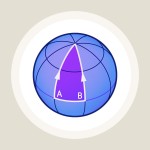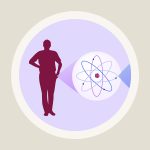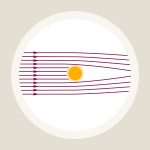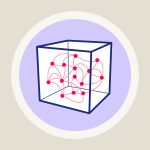General relativity / Elementary Tour part 2: The cosmic dance
In flat, empty spacetime, small test particles follow straight lines. However, just as there are no straight lines on the surface of a sphere, the closest we can come to the notion of a straight line in a curved spacetime is what mathematicians call a geodesic (a spacetime line that is as straight as possible). Small particles in the vicinity of a massive sphere follow spacetime geodesics, which send them plunging toward the mass, or into an orbit around it. Gravity doesn’t deflect these particles from their straight lines. It redefines what it means to move in the straightest possible way.
As a consequence, Einstein’s universe performs an ongoing cosmic dance in which matter and spacetime interact. A given configuration of matter distorts spacetime geometry (not only because of mass, but also with its energy, inner tensions or pressure) and this distorted geometry makes matter move in certain ways. This movement, in turn, changes the matter configuration, and spacetime geometry changes correspondingly. Now that spacetime geometry is a bit different, it also acts on matter in a different way, matter moves, geometry changes, and so on in an endless dance.
If Einstein’s theory had given us no more than an elegant alternative way to describe the effects Newtonian gravity, but no more, it would be intellectually satisfying, but hardly a physics revolution. In fact, Einstein’s theory gives predictions different from its Newtonian predecessor – in some situations markedly different. From Einstein’s point of view, Newton’s theory captures merely a subclass of gravitational phenomena, certain distortions of time that change straight spacetime lines into the parabolas of falling bodies or the closed paths of orbiting planets. Distorted space, the gravitational influence of energy or pressure, the way in which gravity can, in a well-defined way, sometimes be “its own source”: All of these Einsteinian effects are absent in Newton’s description of gravity. We will see some of the dramatic consequences in the following chapters about black holes, gravitational waves or cosmology. However, when Einstein first formulated his theory, he had to rely on much more subtle ways in which his predictions vary from those of Newton’s theory, as we shall see in the next section.










